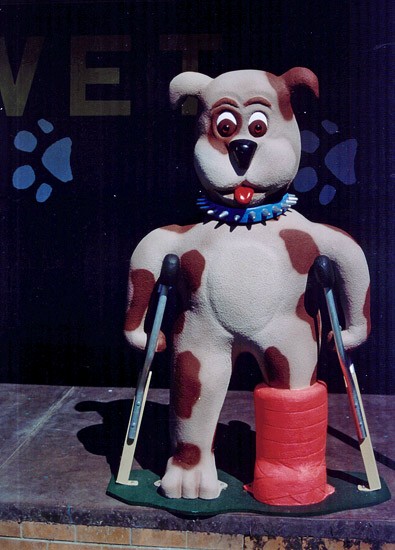STRAINS & SPRAINS –
As with humans, a strain or sprain (for example as the result of a twisted ankle after a trip or fall, or shoulder muscle strain due to landing badly when jumping and playing) needs rest.
The little memory technique for treating a strain or sprain is RICE
R= REST
Crate rest is best as it prevents too much running about or jumping on and off the furniture. As the dog begins to feel better, he often does too much and goes back to square one, so crate rest really helps speed up the healing process.
R= REST
Crate rest is best as it prevents too much running about or jumping on and off the furniture. As the dog begins to feel better, he often does too much and goes back to square one, so crate rest really helps speed up the healing process.
I=ICE
Applying an ice pack or cold compresses may be helpful immediately after the injury & for a few days after. The simplest technique is to apply a bag of frozen food (eg peas) to the area for 10-20 minutes at a time, 4-6 times daily.
C=COMPRESSION
If you are competent in applying a bandage, you can use vet wrap to give support to the limb and keep any swelling to a minimum. Ensure that the dressing is not too tight as this will inhibit circulation. Remember that if the limb begins to swell within the dressing, it might get tighter as the swelling increases so check the dressing frequently making sure that the limb beyond the point of the dressing is a nice temperature – too cold tells you its TOO TIGHT.
E=ELEVATION
As with any injury, a sprain or strain will cause the limb to swell. If we can elevate the inujured part, this will help minimise the swelling a little. Therefore, if you can place the dogs limb on a cushion, this will elevate it enough to help. Obviously, keeping a dog in any one position is tricky, so don’t beat yourself up if the little fella wont oblige!
Homeopathic first aid –
Simple strains and sprains often respond well to Arnica. Instructions for Topical arnica use:-
1 ) Obtain the topical arnica. Topical arnica (also called Leopard’s bane) comes in a variety of forms, such as a tincture of 70 percent ethanol, or in cream or ointment form. It can be purchased at most health food stores and many drugstores.
2) Pour the topical arnica directly onto the bruised area and gently massage it into the skin. The sooner you can apply arnica, the more effective it will be in healing your bruise. Arnica will reduce the swelling, discoloration, and discomfort of the bruised area.
3) Store your arnica at room temperature. Very hot or very cold temperatures can degrade the integrity of topical arnica and may render it less effective.
4) Reapply topical arnica to the affected area according to the instructions on your product label. In general, reapplication can be as often as needed for topical arnica, since the skin will absorb it at an appropriate rate. Topical arnica is safe for use in adults and children, but consult the product label as children require a smaller dose. I would go with children’s dosage for dogs.
5) Discontinue use of arnica if there is any irritation or eczema on skin where it has been applied, as can happen with prolonged use. Don’t use arnica on that area again until the skin is healed.
1 ) Obtain the topical arnica. Topical arnica (also called Leopard’s bane) comes in a variety of forms, such as a tincture of 70 percent ethanol, or in cream or ointment form. It can be purchased at most health food stores and many drugstores.
2) Pour the topical arnica directly onto the bruised area and gently massage it into the skin. The sooner you can apply arnica, the more effective it will be in healing your bruise. Arnica will reduce the swelling, discoloration, and discomfort of the bruised area.
3) Store your arnica at room temperature. Very hot or very cold temperatures can degrade the integrity of topical arnica and may render it less effective.
4) Reapply topical arnica to the affected area according to the instructions on your product label. In general, reapplication can be as often as needed for topical arnica, since the skin will absorb it at an appropriate rate. Topical arnica is safe for use in adults and children, but consult the product label as children require a smaller dose. I would go with children’s dosage for dogs.
5) Discontinue use of arnica if there is any irritation or eczema on skin where it has been applied, as can happen with prolonged use. Don’t use arnica on that area again until the skin is healed.
FRACTURES (danger signs AFTER treatment for fractures)
If your dog has had a broken limb, it is important to follow your vet’s advice to the letter, keeping your dog clam and his activity restricted. However, there are some danger signs we can look out for after treatment which may indicate things are not going well:-
* the dog seems depressed, off colour and is reluctant to eat
* the limb or foot swells up
* pain seems to be increasing rather than decreasing
* surgical wounds are swollen, discharging or not healing
* there is no attempted use of the leg several weeks after surgery
* a discharge is noted from underneath any dressing or around the pins of an external fixator
Should any of these signs occur, please contact your vet ASAP

